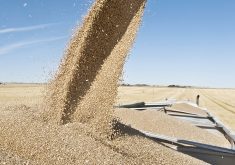The supplies of two major commodities are moving in different directions: hog supply is falling and wheat supply is rising.
Hog producers, those who have survived years of red ink, look toward better times as pork supply drops and demand begins to recover.
Wheat farmers face a bad market year as stocks build despite falling global production.
Our livestock report on page 9 carries numbers from the latest U.S. Department of Agriculture hogs and pigs report. It shows the U.S. herd is three percent smaller than it was a year ago. The breeding herd is down four percent.
Read Also

Soybean market still figuring out implications of China-U.S. pact
Soybean futures had a muted reaction to the U.S. trade deal with China as the market tries to figure out the nuances of the deal.
This puts to rest worries that improving hog futures would cause American producers to slow their herd reduction and wind up producing more hogs than what the futures market was predicting.
Canadian hog farmers who have suffered more because of the rising loonie have cut even deeper.
This should bring pork supply and demand back to a level that will support profitable hog prices. This is particularly true as consumers appear to be spending more on meat as worries about job losses lessen.
The outlook in wheat is less optimistic.
The International Grains Council forecasts 2010 global wheat production will fall to 658 million tonnes from 675 million in 2009, but will still exceed consumption, causing ending stocks to climb to 199 million tonnes, the most since 2001-02.
The burdensome stocks outlook pressured the March Pool Return Outlook for wheat down by $14 to $16 a tonne. CWRS wheat PRO for 2010-11 is now about equal to final payment in 2001-02, the last time stocks were so high.
The difference is that 2001-02 was the low point for the Canadian dollar, trading at about 63 cents US. Today, it is near par.
Analyst Joe Victor of Allendale thinks U.S. wheat prices will soon fall to attract foreign buyers and start to clear the surplus. It would be good if it happened before spring seeding as a signal to cut spring wheat acres even more than planned now.














